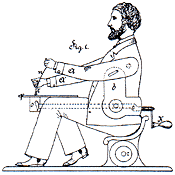Sandt
Toys
The
recent sale of a Sandt designed "Princess"
toy sewing machine has prompted me to include the following
notes for the Site.
The story begins with an 1892 patent by Max Sandt, a works
manager from the Beilefeld district of Germany.
In essence, the patent was concerned with sewing machine frames
in the forms of men or animals, with moving parts, the actual
specification being somewhat lacking in mechanism details.
Interestingly, a shuttle arrangement is mentioned, indicating
a lockstitch machine. However, all known examples using the
design feature a rotary hook, producing a simple chain stitch.
The patent itself makes no reference to the child market,
but it was undoubtedly the "novelty" nature of the idea which
led to its uptake as a toy product.
Within twelve months, the company of Steinfeldt & Blasberg of
Hanover set about production. Contemporary ads show the "Princess"
machine was available in Germany by 1893. The earliest UK advertisement
I have dates from 1894 and illustrates both the "Princess" and
"Clown" forms.
Despite the original patent mentioning animal figures, I am
not aware of any such variants in today's collections.
Of the machines I have observed, it would appear that one
of two main colours was used for the figures' garments, i.e.
blue or orange.
Production lasted only several years at best, therefore extant
examples are few and far between, resulting in the high prices
paid by keen toy collectors today.
It is worth noting that a number of reproduction machines
have appeared in recent times. This is very unfortunate. An
experienced collector can almost certainly distinguish between
a fake and the genuine item, however, the less knowledgeable
should be cautious.
See an original instruction sheet here.
An earlier Max Sandt patent can be found here.
GD
February
2001.




